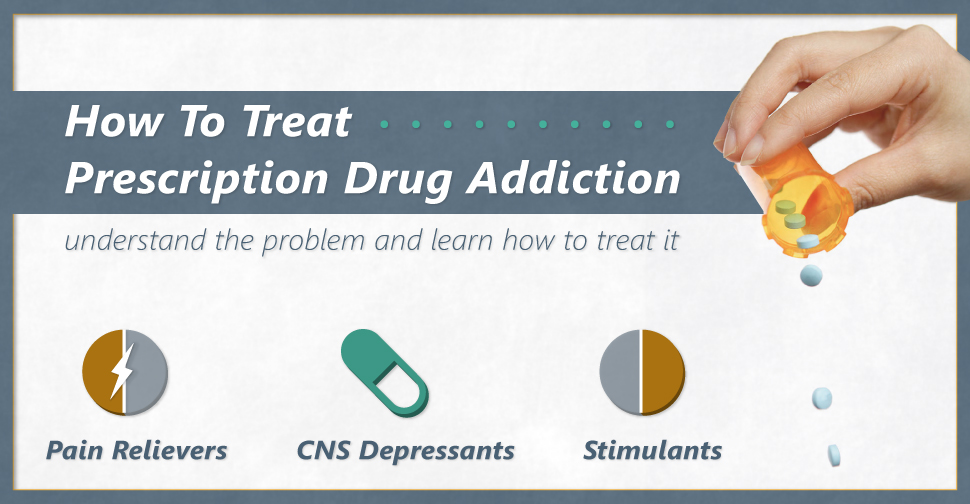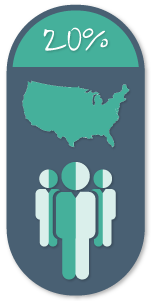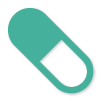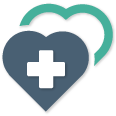
Prescription drugs, while being medically necessary for treating a variety of health problems, also pose a high risk of addiction. Understanding this problem, and how to treat it, is important if you or someone you love is currently suffering from this type of addiction. It is a far more complex subject than many people may realize.
The Root Of The Problem
Prescription drug abuse is highly problematic and one of the most dangerous plagues sweeping our nation. Some research suggests that 20 percent of the nation (or 48 million people) have abused prescription drugs. Though the statistics aren’t available for addiction, if even 10 percent of those who abused them were addicted, that would be nearly five million addicted people.
 Why are prescription drugs abused? Some abuse them simply to get high during experimental phases in their lives. The belief that prescription drugs are “safer” than illicit substances may encourage others to turn to them as a surrogate for illegal drugs. Others gradually begin to abuse prescription drugs after the symptoms they were designed to manage grew worse, requiring higher doses.
Why are prescription drugs abused? Some abuse them simply to get high during experimental phases in their lives. The belief that prescription drugs are “safer” than illicit substances may encourage others to turn to them as a surrogate for illegal drugs. Others gradually begin to abuse prescription drugs after the symptoms they were designed to manage grew worse, requiring higher doses.
Whatever the root of the problem, it is important to bring abuse and addiction to the surface and find ways to treat it. It is also important to understand the types of prescription drugs that are abused.
Commonly Abused Prescription Drugs
 There are three main types of prescription drugs abused in America: pain relievers, central nervous system (CNS) depressants (including tranquilizers and sedatives), and stimulants.
There are three main types of prescription drugs abused in America: pain relievers, central nervous system (CNS) depressants (including tranquilizers and sedatives), and stimulants.
Addictive pain relievers are typically opioid drugs that stimulate high levels of pleasure. Morphine, Vicodin,  OxyContin, fentanyl, and codeine are all in this category. They create a euphoric high that is similar to heroin (a drug that falls within the same class) and which can be highly addictive if abused.
OxyContin, fentanyl, and codeine are all in this category. They create a euphoric high that is similar to heroin (a drug that falls within the same class) and which can be highly addictive if abused.
 Tranquilizers and sedatives typically fall under the heading of barbiturates or benzodiazepines. They manage anxiety and insomnia by slowing the function of the brain. Unfortunately, they can also produce an addictive state, especially if a person can no longer sleep or function without them. Xanax and Valium are both in this class of substances.
Tranquilizers and sedatives typically fall under the heading of barbiturates or benzodiazepines. They manage anxiety and insomnia by slowing the function of the brain. Unfortunately, they can also produce an addictive state, especially if a person can no longer sleep or function without them. Xanax and Valium are both in this class of substances.
Stimulants, such as Ritalin and Adderall, increase the functioning of the brain to help a person focus more efficiently. They are typically used to treat problems like narcolepsy, ADD, and ADHD. They are addictive when abused because they enhance feelings of pleasure in the brain by boosting dopamine. This can create a feeling of euphoria, in an intensity which cannot be found naturally.
Although other prescription medications, such as cough syrup, also have an addictive quality, these three drug types are the most commonly abused. Beyond the problems caused by addiction (including declining physical health, psychological concerns, and risk of overdose) are a variety of problems unique to prescription drug abuse and addiction.
Problems Associated With Prescription Drug Addiction
When trying to manage an addiction to prescription drugs, it’s possible to run into a range of problems that make it more difficult. For example, it is possible that the substance is still needed to manage anxiety or pain symptoms in a positive way. Beating an addiction only to again fall victim to severe anxiety or unmanageable pain may lead some to return to the illicit use of these drugs.
Other problems include the misconception that it is “safer” to abuse prescription drugs than it is other substances. This might cause family and friends to give their loved ones their prescription in order to help them manage their issues or their withdrawal. It might also make a person dangerously think that they don’t have a problem.
Unfortunately, prescription drug addiction is just as serious as addiction to other substances. This makes it necessary to treat it in a variety of ways. For example, withdrawal from the specific substance must be undertaken, followed by treating the psychological problems that either helped to create the addiction, or that were caused by addiction. This treatment includes finding a new medicine to replace the addictive substance in the person’s medical regimen.
Withdrawal Must Be Carefully Managed
When managing withdrawal from prescription medications, it is important to identify the nature of your substance. Remember that prescription drugs come in multiple types, and that withdrawal will vary depending on the type of substance abused. For example, withdrawing from prescription opiates will require the use of replacement medications like buprenorphine.
Other substances, such as some sedatives, require different medications, such as safe doses of benzodiazepine medications that are medically-tapered to avoid severe withdrawal symptoms.

According to the National Institute on Drug Abuse, there are currently no FDA-approved drugs for treating an addiction to stimulants, however, they do note that behavioral therapies are especially useful. In cases of extreme agitation, certain medications may be used to help the client relax, including diazepam (Valium).
Withdrawal from any kind of prescription drugs is likely to cause a variety of problems, including nausea, confusion, vomiting, fever, shaking, anxiety, depression, problems with sleeping, and others. Replacement medications will help a person detoxify safely and prepare them for the psychological assessments that are necessary when managing addiction.
Psychological Concerns Are Managed
Addiction to prescription medications may be caused by psychological problems, such as anxiety or bipolar disorder, compelling someone to use higher levels of drugs than is necessary to treat these concerns. These psychological conditions will be exacerbated by many substances, with stimulants in particular causing a variety of problems. Even when a person quits taking drugs, those problems don’t go away.
As a result, it is necessary to manage these problems before addiction can be fully beaten. This is possible through the use of dual diagnosis treatments. This treatment method simultaneously attacks both addiction and any underlying mental health problems to ensure that the severity of both are decreased safely and effectively. This is especially important, because it works towards identifying any triggers or maladaptive behaviors that may be rooted within these psychological disorders, and alleviate them so that they don’t lead to further abuse or addiction.
For example, psychological counseling may identify what causes a person’s anxiety and teach them ways to relax without their anti-anxiety medication, or teach them how to utilize this in conjunction with a new medication. For severe problems, like schizophrenia, the situation is more complex. A person with problems that serious can’t afford to stop taking medications for good. As a result, new medicines must be investigated to help them maintain a high quality of life.
New Treatments For Health Problems Must Be Assessed
Once the person has been detoxified from their addictive prescription drug, new treatments must be found to help them manage the problem their prescription was helping. For example, new anxiety medications without an addictive potential may be prescribed or relaxing techniques like meditation mastered. Pain-relieving measures, such as physical therapy, may be necessary for those who yet need their pain managed.
In many ways, this will be the toughest part of rehabilitation. It will require working to find a treatment method that works just as well as the former prescription medication, but without fueling the addiction. Once new treatment methods have been prescribed, it is important to master the prevention of relapse.
Aftercare And Relapse Prevention Is Another Key Focus
 Relapse is a serious problem with any kind of addiction, and is particularly potent for prescription drugs. Their legal status makes them easier to obtain than substances like heroin, and the necessity of taking them also makes it hard for many to avoid relapsing. This is why relapse prevention and aftercare treatment is so highly emphasized in treating this kind of addiction.
Relapse is a serious problem with any kind of addiction, and is particularly potent for prescription drugs. Their legal status makes them easier to obtain than substances like heroin, and the necessity of taking them also makes it hard for many to avoid relapsing. This is why relapse prevention and aftercare treatment is so highly emphasized in treating this kind of addiction.
Aftercare and relapse prevention focuses on identifying triggers that lead to using substances. With prescription drug addiction, this is tricky as triggers might be caused by physical or mental pain that must be treated. Managing these symptoms through alternative means is necessary. Reaching out to others for help is another part of aftercare and relapse prevention, specifically a sobriety group.
Often, behavioral adjustment techniques, including cognitive behavioral therapy, may be necessary to help a person correct negative thoughts and unhealthy behavior patterns. The goal of aftercare and relapse prevention is to prepare a person for the kind of personal diligence and focus that is necessary for creating a life free from addiction.
Getting The Help You Deserve
 Beating addiction to prescription medications is possible with a professional treatment model that focuses on managing the negative side effects of addiction in a positive way. To learn more about this process, please contact us at DrugRehab.org today. We can find you the help you need to master sobriety once and for all.
Beating addiction to prescription medications is possible with a professional treatment model that focuses on managing the negative side effects of addiction in a positive way. To learn more about this process, please contact us at DrugRehab.org today. We can find you the help you need to master sobriety once and for all.
Sources
National Council On Alcoholism And Drug Dependence – Prescription Drugs
National Institute On Drug Abuse – What is Prescription Drug Abuse?
Substance Abuse And Mental Health Services Administration – Prescription Drug Misuse and Abuse
Dartmouth – Dual Diagnosis: Mental Illness And Substance Abuse
National Institute On Alcohol Abuse And Alcoholism – Relapse Prevention: An Overview of Marlatt’s Cognitive-Behavioral Model

